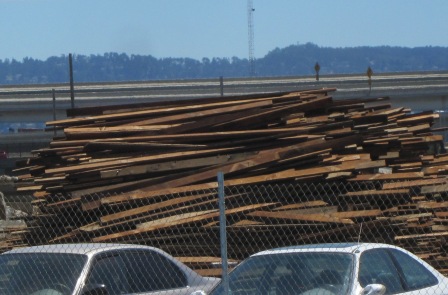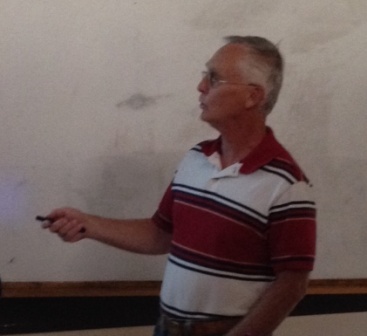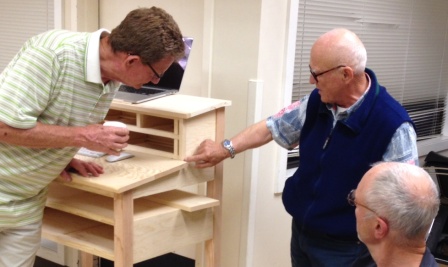President's Message
Fellow woodworkers,
I predict: lots of recycled old growth Douglas Fir and Redwood becoming available, a shortage of white Oak and much bigger selection of fine American Whiskies.

I frequently see the old Oakland Army Base as I drive passed on I 880.
It was built on the mud flats of Oakland's outer harbor in 1941 and in regular use until 1999. The land is now the focus of a major redevelopment in Oakland and after many years work has started on clearing the site of its old warehouses and barracks ready for the new developments.
As you drive by you see the 7 enormous warehouses, each enclosing over 233,000 sq. ft. They were made when cost was not a consideration as we were getting ready for war and large old-growth trees were plentiful. As part of its wartime efforts the government acquired large sections of forest land in northern California, Oregon and Washington. The warehouses have large Douglas Fir beams and trusses with Redwood angled sheathing planks and horizontal sidings. These warehouses are now being are being "deconstructed", a new word for me but implies carefully taken down, and the wood is being prepared for sale. The Redwood sash window frames and doors are also being recycled. The timbers are thick old growth Douglas Fir and Redwood. The Architectural Salvage Assessment document describes the method of construction as "wood-frame, notably heavy timbers".
Around the site you can see beams stacked in very neat piles and the sidings piled up in great stacks.


For those of you who are interested, there are some great pictures of the site in the Architectural Salvage Assessment report:
http://www2.oaklandnet.com/oakca1/groups/ceda/documents/report/oak031226.pdfAbout 45 miles south at Moffet Field in Mountain View are the gigantic hangers left over from the days of the WWll airships.
Hanger One at Moffet Field is described as one of the largest freestanding structures in the world covering an area of 8 acres.
Google executives (not Google the company) now lease Hanger One and are fixing it up and going to rehabitate the other 2 gigantic hangers at Moffitt field. The result is that large quantities of 1930's old growth Californian Redwood are now on the market.
You can find the wood at: terramai.com (Note the minimum order is $2500.)
There is also a story in a recent Time Magazine about the growth of the bourbon distilling business in Kentucky: "the number of barrels aging whiskey in Kentucky out-numbers the number of residents by more than 1 million" This has resulted in a big demand for white oak. (According to Wikipedia the population of Kentucky is about 4.4M)
The law states that American whiskeys like bourbon can only be aged in charred oak containers. Apparently charred white oak gives the right flavor even though it smells like campfire roasted s'mores, plus white oak's water-tight cells are good for barrels of liquid. Several new barrel-making facilities are being built so there are employment opportunities for you if you are a skilled cooper.
So there should be plenty of old reclaimed Douglas Fir and Redwood available (all be it expensive), there will probably be a shortage of good white Oak but there will be plenty of American Whiskey provided you can accept the roasted s'mores touch.
We welcomed Arnie back from his stay at the Veterans Hospital were in between our May and June meetings he had triple bypass surgery. We wished him a smooth recovery.
Enjoy your woodworking
Frank (Contact at: Frankramsay8@aol.com)
Frank called the meeting to order at 7:00, right on time.
New Members and Guests:
Joining as guests tonight were the owners of the Parkside Rascals childcare center in Daly City where BAWA sent its Rebuilding Together team. Paulette and Rick we welcome you to BAWA. Paulette gave us an appreciative thank you for the wonderful contribution and construction.
Announcements:
Claude Godcharles reminded us that the Wood Show is fast approaching and that entries are due by September 18, the day of the BAWA meeting. To paraphrase a racing idiom: Gentlemen and women start your projects. The show will be held October 17/18/19 at Woodcraft in San Carlos.
Per Madsen:
Per reviewed the upcoming meeting schedule:
July—Roger Heitzman, furniture designer and builder discussing his art nouveau desk and chair
August—Open
September—Chris Weiss will be discussing Japanese hand tools, tuning and use.
October—Wood Show, no formal meeting.
November—The wood show judges will discuss and critique the entries
December—The annual potluck dinner
Claude Godcharles announced that he is making wood screws for Moxen vises. He is taking orders.
Two items are in the Silent Auction tonight: a thin kerf 10" saw blade and a lumber rack from Lee Valley.
The Tech Shop has moved from Menlo Park to San Carlos, next to the refuse transfer station off 101. They are offering a 3-month membership along with two classes for $300.

Dan Goodman gave a brief slide presentation showing the work of the BAWA Rebuilding Together team at Parkside Rascals daycare center. The additions included: a new patio, remodeled playhouses, new stairs, monkey bars, a closet, shade structures between the playhouses, a trash can screen fenced area, and a Swiss Chalet. Many other partners assisted in the effort and the results were remarkable. The food was remarkable, too. Rick and Paulette presented BAWA with a picture of the team, signed by all the kids.
See pictues of the event in Dan's presentation: Dan's presentation
Ken Napier—Reproducing Antique Furniture

Ken began his career as a clerk in an architectural shop shortly after he got out of the service. He retired as a structural engineer. He has long had a fascination with antique furniture and began his woodworking in 1981.
Tonight he will give us a overview of this specialty. He builds antique reproductions because it is fun, challenging and gives him a deeper appreciation of the craft. The effort requires planning and that starts with knowledge, much of it gained from reading. He recommends Fine Points of Furniture by Albert Sack, available from Amazon for $25. The rest of his reading list is available upon request.
Fine furniture can be evaluate as "best" by looking at several facets of the piece:
Functionality
Proportionality
Materials
Details
Finish
In 1991, Ken decided to challenge himself by making a Queen Anne Secretary cabinet. He wanted to learn something new. It has 11 secret compartments. House guests and grandchildren become enthralled with finding them. The planning process for the piece involved many sketches, then detailed plans that he does by hand. Afterwards he always records in his notebook the lessons learned.
How should someone who in interested in pursuing antique reproductions begin? He recommends the following:
Pick a country
Pick a period of time
Pick a style
Do your research, learn about the cabinet makers, ie
Thomas Chippendale, UK
Thomas Elfe, Charlestown SC
John Goddard Newport, RI
Sam Maloof, SoCal
The Golden Age of Furniture is generally considered to be the time period 1750-1800. Style elements included the Ogee foot, the Ball and Claw foot and Quarter Columns. Elements were mixed and matched.
The Golden Mean (1.1618) is widely used in furniture from this period and today. It has stood the test of time.
Ken recommends doing your research and points to sources such as museums (Art Museum of Philadelphia, historical homes (Winterthur), and books.
Reproductions of furniture can be exact, look-alike, or better. There is a place for everyone and everything. Just try to stay true to the period and style. Try making a list of the design elements you like, such as: top pediment, case, doors, legs and feet. Consider the materials you want to use: sawn wood, plywood or MDF, veneers. Consider the grain pattern and figure (NPI) out how it will all come together. Think in 3D. Small details matter.
Let's start at the top
Do you want it straight and flat, sloped, swan neck, full bonnet, with applied or solid carvings, or perhaps even turnings?
Then we go to the casework
Will the joints be visible or concealed? Dowels, dovetails, even box joints have appeal.
And standing on legs
Will the legs be straight, tapered (inside or out), even lathe turned. He showed us a photograph of a drop leaf table he made with a 5th leg attached to a pull out drawer supporting the extended drop leaf. There is room for innovation and imagination in reproductions.
Feet on the ground
Bracket feet can be made with an ogee pattern and an S-curve. With curved feet, less is better. He starts his feet with a long board and makes them in sequence, using a jack plane to smooth the complex curve. A pattern shows where to drill the round hole with a Forstner bit. He splices a dovetailed right-angled structure to the inside of the foot. It is slightly taller than the foot so that it bears the weight of the cabinet. Feet can be tapered, turned or even a ball and claw.
Door rails and stiles can be joined with half lap joints, miters, or cope and stick. The strongest is the half lap joint, the weakest is the cope and stick. Panels can be raised or flat, arched or straight.
Drawers can be constructed with dovetails, box joints, dowels and interlocks. Door slides can be metal or wood, although Blum door slides with soft close features are not considered appropriate in antique reproductions. Drawer height in a cabinet can be pleasing if the height is graduated from bottom to top, heavier on the bottom.
Small details add significantly to a cabinet: carvings, dentils, frets and cock beading are all possible. Then you can look at marquetry, inlays even the hardware. The key is "to provide a little bit more."
Other areas to explore include finishes, sealers, dyes and stains. Horton Brass makes excellent reproduction hardware. Secret places always add intrigue. He has such compartments in everything he makes. Now, instead of springs, he is using more rare earth magnets.
And where do we go from here? BAWA will be adding a feature to some of its meetings. We will have a 15-minute mini seminar on specific design features of furniture. If you have requests, please let Per Madsen know what you would like to see. And if you would like to contribute, that would be good too.
Then Ken showed us some photographs of reproduction pieces and gave us a quiz. Would you judge the photographed piece to be Good, Better or Best? We all passed. We had an outstanding instructor.
Show and Tell:
John Blackmore brought in a prototype of a stand-up desk he plans to make. The prototype was constructed of white pine. The front sloping section is intended as a working surface with space for papers, a wireless keyboard and mouse. The elevated back section holds the computer at eye height. The lower surface is hinged allowing for storage. An open shelf rests below the working surface and underneath it is a drawer set.
The upper case of the unit has two wide, vertical board surfaces and audience comments generally concerned cross wood movement between these surfaces and the legs. John was asked where his prototype fits in the Napier grading scale: good, better or best. John replied that it is only the beginning; prototypes and comments are good.
The Senior Center staff were scurrying to close the building since it was after 9pm so BAWA adjourned until next time.
John BlackmoreSecretary johnblackmore@comcast.net
